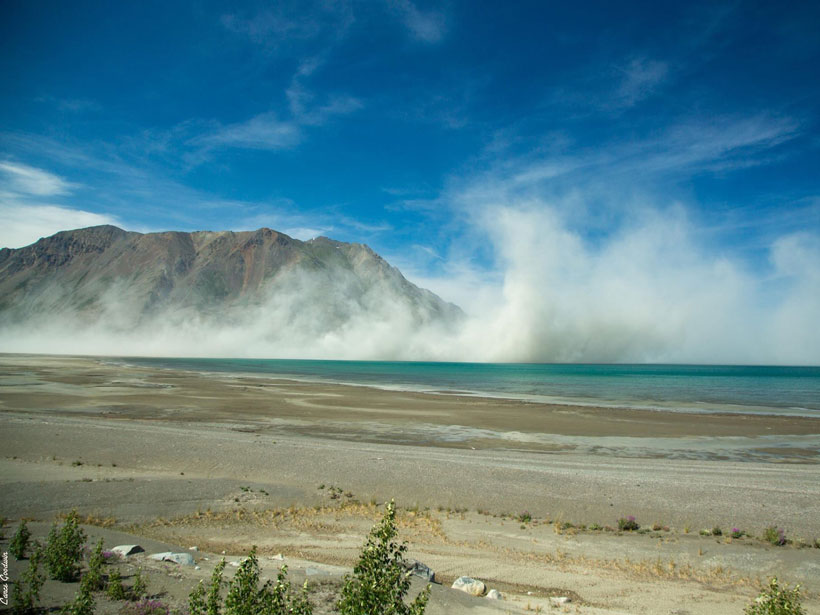
In spring 2016 in the remote northern reaches of Yukon, Canada, a glacier melted so quickly that its meltwater cut a new path through the ice and changed the course of the Ä’äy Chù, or Slims River. When the old riverbed dried out, the basin’s fine-grained dirt (created by glaciers grinding against bedrock) became airborne dust, with major impacts on local air quality and, according to a new study, perhaps effects on global climate.
In the first research of its kind to take place in the Canadian North, scientists collected and analyzed the quantity and properties of airborne dust created by the receding glacier. Through this work, the team hopes to better understand how aerosols from newly exposed Arctic soils can affect regional air quality and larger climate patterns, said Patrick Hayes, an atmospheric chemist at the University of Montreal in Quebec.
“There’s a lot we don’t know about aerosols and how aerosols impact climate,” said Hayes, who presented the research at AGU’s virtual Fall Meeting 2020. As glaciers continue to melt at runaway speeds, they’ll expose more dust in their wake. Understanding “the amounts and the composition can hopefully provide some insight into the climate [and air quality] effects” of these expanding sources of fine-grained debris, Hayes said.
Collecting and Sifting Fine Dust
Hayes and his team, including coauthor James King, a geoscientist at the University of Montreal, collected samples of dust in summer 2018 at eight locations spread throughout the Ä’äy Chù river delta. They used a combination of contraptions to collect and analyze samples, both floating through the air and deposited onto their equipment.
At times, the generators required to work some of the instrumentation gave out. In such a remote location, that could have seriously hampered the team’s research. “I’m a chemist, not a mechanic,” said Hayes, noting that driving to the nearest small town to fix a generator would have used up 6 hours of precious sampling time.

But local community members of the Kluane First Nation were willing and enthusiastic supporters of the research, said Hayes, from helping repair equipment to letting the team “put some kind of weird gizmo on their lawn, and let us just leave it there all summer.” The relationships and trust the researchers built with the community were crucial to the project’s success.
Local Dust with Global Impacts
The researchers looked at the size and chemical makeup of the particles, as well as the volume of dust emissions from the area. The dust was overall much finer than expected compared with hot spots in the lower-latitude “global dust belt,” such as the Sahara and Gobi deserts. On windy days, the dusty emissions exceeded the World Health Organization’s limits on acceptable amounts before air quality becomes a public health risk, including at the more frequently visited tourist sites.
One major finding and a concern to the local community was surprisingly high amounts of arsenic, most likely due to a process known as “sandblasting.”
One major finding, and a particular concern to the local community, was surprisingly high amounts of arsenic, most likely due to a process known as “sandblasting.” When large particles get blown a short distance by the high winds common in the Arctic, they act “like a missile” when they hit the ground, Hayes said, shattering fragile particles into dust upon impact.
“It’s the [arsenic-containing] particles in the soil that tend to be more fragile, and they generate more fine dust during the sandblasting,” he said.
The researchers also measured poor air quality near the dust source—at times exceeding World Health Organization air quality thresholds for small inhalable particulates, those measuring less than 2.5 micrometers across (PM2.5).
Dust in the atmosphere can also create clouds, said Christian Juncher Jørgensen, an Arctic environmental researcher at Aarhus University in Denmark who is familiar with this research. Depending on where in the atmosphere they form, Jørgensen said, dust-spawned clouds can have either a warming or a cooling effect. The team’s findings about the types of dust liberated by vanishing glaciers at high latitudes “are important for future predictions” of climate change, said Jørgensen.
“[This study] can be seen as a proxy for how the future might be if major glaciers of the Earth retreat in a substantial way,” he said.
Hayes and his colleagues hope to return to their testing sites in summer 2021 to investigate how windblown dust interacts with clouds and scatters and absorbs light from the Sun, which could have further impacts on climate.
—Emily Harwitz (@emilyharwitz), Science Writer
Citation:
Harwitz, E. (2020), Dust from receding glaciers may have major atmospheric impacts, Eos, 101, https://doi.org/10.1029/2020EO152677. Published on 16 December 2020.
Text © 2020. The authors. CC BY-NC-ND 3.0
Except where otherwise noted, images are subject to copyright. Any reuse without express permission from the copyright owner is prohibited.

